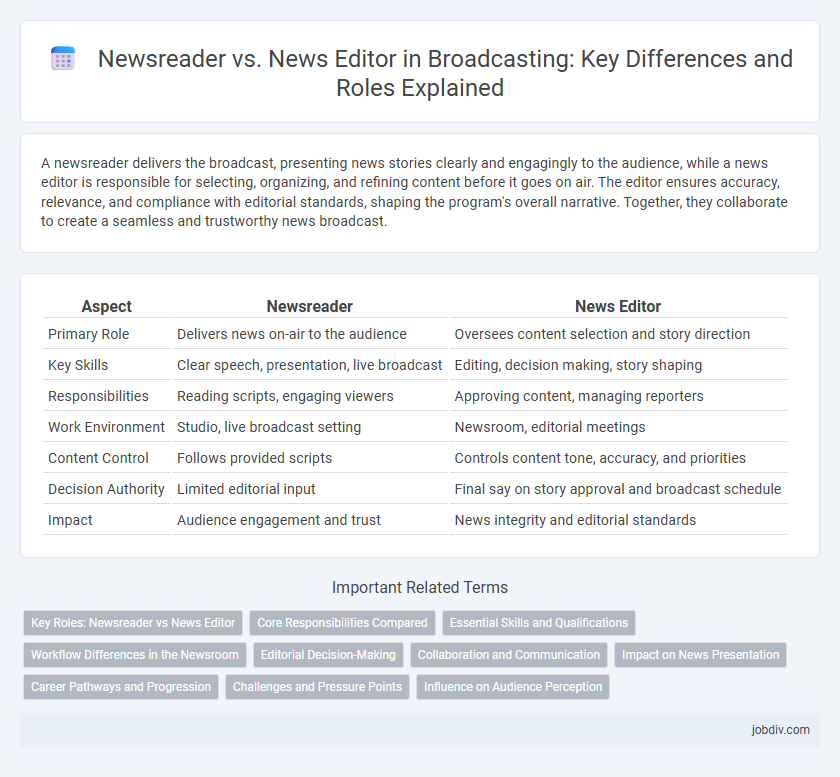A newsreader delivers the broadcast, presenting news stories clearly and engagingly to the audience, while a news editor is responsible for selecting, organizing, and refining content before it goes on air. The editor ensures accuracy, relevance, and compliance with editorial standards, shaping the program's overall narrative. Together, they collaborate to create a seamless and trustworthy news broadcast.
Table of Comparison
| Aspect | Newsreader | News Editor |
|---|---|---|
| Primary Role | Delivers news on-air to the audience | Oversees content selection and story direction |
| Key Skills | Clear speech, presentation, live broadcast | Editing, decision making, story shaping |
| Responsibilities | Reading scripts, engaging viewers | Approving content, managing reporters |
| Work Environment | Studio, live broadcast setting | Newsroom, editorial meetings |
| Content Control | Follows provided scripts | Controls content tone, accuracy, and priorities |
| Decision Authority | Limited editorial input | Final say on story approval and broadcast schedule |
| Impact | Audience engagement and trust | News integrity and editorial standards |
Key Roles: Newsreader vs News Editor
A newsreader delivers news stories directly to the audience, ensuring clear and engaging presentation on air, while a news editor manages the editorial content, selecting and verifying news items to maintain accuracy and relevance. News editors coordinate newsroom activities, oversee reporters, and make decisions about story priorities, shaping the overall news agenda. The key distinction lies in the newsreader's role as the public face of the broadcast versus the news editor's behind-the-scenes responsibility for content curation and quality control.
Core Responsibilities Compared
Newsreaders primarily focus on delivering news content to the audience with clarity and professionalism, ensuring accurate pronunciation and engaging presentation. News editors are responsible for overseeing the selection, verification, and organization of news stories, maintaining editorial standards, and guiding the overall narrative. The news editor's role involves critical decision-making about content relevance and quality, while the newsreader concentrates on effective communication and audience engagement.
Essential Skills and Qualifications
Newsreaders require excellent verbal communication skills, clear diction, and the ability to engage viewers while delivering news accurately under tight deadlines. News editors must possess strong editorial judgment, attention to detail, and proficiency in content management systems to oversee story selection, script editing, and coordination with reporters. Both roles demand a solid understanding of current events, journalism ethics, and often a degree in journalism or mass communication.
Workflow Differences in the Newsroom
Newsreaders deliver scripted news content live on air, focusing on clear communication and audience engagement, while news editors manage the newsroom workflow by selecting, verifying, and shaping news stories before broadcast. News editors coordinate with reporters, organize story priorities, and ensure editorial standards, enabling newsreaders to present well-prepared segments effectively. This division of labor streamlines news production, balancing editorial control with engaging broadcast presentation.
Editorial Decision-Making
News editors oversee editorial decision-making by determining which stories make the broadcast and shaping content to meet journalistic standards. Newsreaders focus on delivering the finalized news script with clarity and professionalism, ensuring viewer engagement through effective presentation. Collaborative efforts between news editors and newsreaders enhance content accuracy, relevance, and audience trust in broadcasting.
Collaboration and Communication
Effective collaboration between newsreaders and news editors is essential for delivering accurate and engaging broadcasts. News editors coordinate content, shape editorial direction, and provide real-time updates, while newsreaders convey the information clearly and confidently to the audience. Seamless communication ensures alignment on breaking news, tone, and timing, enhancing overall broadcast quality and viewer trust.
Impact on News Presentation
Newsreaders directly influence news presentation by delivering stories with clarity and appropriate tone, shaping audience perception through vocal emphasis and body language. News editors impact the final broadcast by selecting, organizing, and refining content to ensure accuracy, coherence, and relevance, ultimately determining the narrative structure. The collaboration between newsreaders and news editors enhances the credibility and engagement level of news programs, balancing presentation style with editorial judgment.
Career Pathways and Progression
Newsreaders typically begin their careers by gaining on-air experience through internships or junior presenter roles, gradually building their voice and presentation skills to become main anchors. News editors often start as reporters or assistant editors, advancing by mastering story selection, newsroom management, and editorial decision-making, which leads to senior editorial positions. Career progression for newsreaders focuses on public recognition and audience engagement, whereas news editors advance through developing leadership capabilities and content strategy expertise.
Challenges and Pressure Points
Newsreaders face intense pressure to deliver live broadcasts flawlessly while maintaining engaging and clear communication to retain audience trust. News editors encounter challenges in quickly verifying information, managing breaking news workflows, and balancing editorial standards with tight deadlines. Both roles must adapt rapidly to evolving news cycles and digital platforms, intensifying their responsibilities under constant public scrutiny.
Influence on Audience Perception
Newsreaders deliver information with tone, body language, and clarity that directly shape audience engagement and trust, making them pivotal in how news is perceived. News editors curate content, deciding which stories reach the audience, framing narratives that influence public opinion and the perceived importance of issues. Together, their roles create a balance between presentation style and content selection that profoundly affects audience perception in broadcasting.
Newsreader vs News Editor Infographic

 jobdiv.com
jobdiv.com